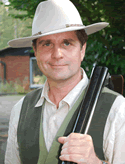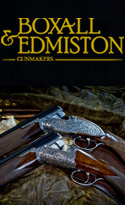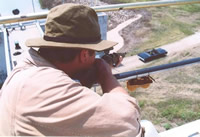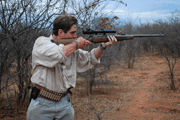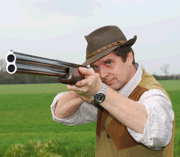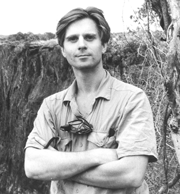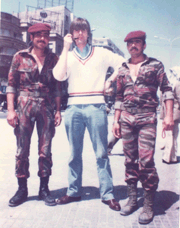Lincoln Assassination Attempt - Abraham Lincoln and the Sniper
The President, during the heated season, occupies a country house near the Soldiers' Home, two or three miles from the city. He goes to and...from that place on horseback, night and morning, unguarded. I go there unattended at all hours, by daylight and moonlight, by starlight and without any light.
Secretary of State, William Seward, July 15, 1862.
Crook, do you know I believe there are men who want to take my life? And I have no doubt they will do it.....I know no one could do it and escape alive. But if it is to be done, it is impossible to prevent it.
Abraham Lincoln to bodyguard, William H. Crook, on April 14, 1865
[He was assassinated later the same day at Ford’s Theatre but Crook was not present. On the day of his assassination, John F Kennedy, also noted how easy it would be for an assassin to shoot him from one of the high buildings that his cavalcade was to pass in Dallas.]
“Get down, you damn fool, before you get shot,” shouted Oliver Wendall Holmes, then a young Union army officer (and later a famous Supreme Court Judge), to the tall man in a stove pipe hat standing near him on the parapet. Apparently, he had not recognised the towering figure (6’ 6” without the hat), and made his comment in extremis as a man between them fell to a Confederate bullet. Lincoln showed no fear, but complied with the soldier’s impatient but sensible advice.
During 1864, the Confederate Army advanced just north of Washington DC. People came out to watch the ensuing battle - among them the president. It seems possible that someone was deliberately firing at him. Holmes may not of recognised him from behind at a range of a few feet, but he must have been a tempting and, possibly, recognisable target to the Rebs. A slight error in windage and the next man would take the bullet. It was certainly news to me that someone might have taken a pot shot at Lincoln before he was shot by the disaffected actor John Wilkes Booth in the Ford theatre (and thus achieved the dubious distinction of being the first US president assassinated).
Nor, was I aware that there had been at least a couple of actual or plotted attempts on Lincoln’s life before that fateful day in April 1865. Charles Pinkerton - the man who went on to found the detective agency and who was at one point Lincoln’s head of security - foiled a plot to kill the then President-elect at Calvert Street station at Baltimore. [Lincoln got off the train and rode to Washington. There is no record of what happened to the plotters]. On another occasion, Abe, by now sworn in and established in office, returned from a Washington walk with a bullet hole in his hat.
As you may have already guessed by the accompanying photographs, this historical snippets are by way of background, to my latest documentary film project: an experiment concerning a possible attempt on Lincoln’s life whilst standing on the aforementioned parapet. I am used to getting some interesting commissions from Hollywood, this was as intriguing - and challenging - as any I have yet undertaken, not least because I am far from being an expert with a muzzle-loading rifle.
Could a really long range shot be made consistently under field conditions? What was more likely in this case - a stray bullet or an aimed shot from a sniper? Long barrelled percussion rifles are certainly capable of accurate fire out to 500 yards or so and civil war era marksmen used them most effectively at both individual and concentrated targets (some accounts note shots in excess of 1000 yards). The range in question here? Well no-one seems quite clear, but the producer - bless him - decided on half a mile. Of course, I accepted this modest 800 yard challenge immediately and then worried about how to accomplish it (while thinking of how distant a deer appears at 300 paces through a modern scope).
Although my muzzle-loading CV is a bit slight, I reasoned that there is not much with a trigger and a barrel that he has not shot over the years. Do not get the wrong impression, I do not claim to be the greatest shot on the planet - however good you think you are, there are always dozens better - but, I have been knocking around it, gun in hand, for 40 years or so. By means of determination, guile, and practice (30,000 or so rounds a year), I can hold my own with most people. It’s a bit like being one of those pilots who can fly any plane, I pride myself on being able to shoot just about any gun.
So, a first shot kill at 800 yards with an open sighted muzzle-loader shouldn’t pose a significant problem. Should it? Well…they do it at Bisley all the time…don’t they? Hmmm… They do, but I don’t. That was the discomforting bottom line. And, some nasty little demon also reminded me that I had once owned a Parker Hale .451 Whitworth Volunteer rifle and never could get the damn thing to shoot properly. Many have since told me of the good qualities of the 451 replicas. [In retrospect, the poor shooting of mine may have been caused by inappropriate loads. I eventually donated the gun to the Artist’s Rifles club. Perhaps someone else made it shoot.]
I also played with an original Enfield many years back. That was a carbine and I remember being disconcerted by the recoil. My muzzle-loading experience did include some work with cap and ball revolvers (I still have an Italian Walker) and percussion shotguns. As importantly, I had shot centre-fire rifles at long range in the Army at figure 11s and, on various occasions since at bullseye targets. I knew from this experience that reading the wind would be the main problem at 800 assuming one was able to get the kit sorted out first.
Thus, I found myself on another plane to the USA (first stop Boston, then Norfolk Virginia). The shooting - with guns and camera - was to be done at an impressive range complex - Blackwater - in Virginia that is used by both civilians and the military. The film company had only offered one day to set the guns up and shoot them (I had advised that this might not be enough). I always like to have a planning and prep’ day to get everything sorted.
There were two replica Whitworths in .451 (one a Parker Hale, the other from Navy Arms), both equipped with the famous mechanical rifling system - where the large hexagonal bullet is a machine fit in the bore. [You can get Henry rifled ‘Whitworth’ replicas today as well, but we opted for authenticity.] As well as hexagonal bullet guns, there was a more conventional .577 Enfield of long pattern as a back-up, and the choice of two period optical sights.
Both of the telescopes were quickly abandoned as impractical for long range shooting. One was side mounted, and almost impossible to use without a dreadful contortion, the other was incapable of being elevated sufficiently for a 400 yard shot, let alone one at double that range. Happily, the two Volunteers appeared serviceable. I opted for the Parker Hale in spite of my previous experience. It belonged to someone at the US National Firearms Museum (located at the NRA headquarters in Fairfax Virginia).
It looked great, but there was a slight problem with the front sight - it was loose and would have to be secured before any trials began (I still preferred the profile of the foresight to the other gun). There was no punch to hand so I knocked the sight out of its groove at the muzzle end of the barrel and peened its tongue before tapping it back into a central position and creating a tell-tale datum on both barrel and sight in case it moved. After a little discussion about loads (we started with about 70 grains of BP behind the big bullet) - zeroing began.
Firing started at 30 yards. The gun grouped well, key-holing some shots. Time for 100 yards and another pleasant surprise - the first shot was absolutely perfect, smack bang on the aiming mark. “It don’t get better than that” as my companion in arms, Phil Schreier, of the US National Firearms Museum noted. Famous last words, though. Shortly afterwards, the wretched front sight started waggling again. Return to go. We persevered. Made a field repair. Re-checked zero and moved back to 400 yards.
All the while there were some fit young Englishmen watching us with interest with some US companions. I never did find out who they were, but noted that the range was frequented by SEAL units (and owned by ex-SEALs). My educated guess was that these were boys on attachment from the SBS or something similar. Everyone seemed intrigued by the intrinsic accuracy of the old guns. After a couple of shots, I was on target at 400. My first non-zeroing shot hit the right-hand target of three silhouettes. I had aimed centre, but there was a lot of wind. Could this have been what happened in 1864? I wouldn’t find out that day. The next bullet jammed in the bore. Oh bother.
Lincoln’s strange dream
About ten days ago, I retired very late. I had been up waiting for important dispatches from the front. I could not have been long in bed when I fell into a slumber, for I was weary. I soon began to dream. There seemed to be a death-like stillness about me. Then I heard subdued sobs, as if a number of people were weeping. I thought I left my bed and wandered downstairs. There the silence was broken by the same pitiful sobbing, but the mourners were invisible. I went from room to room; no living person was in sight, but the same mournful sounds of distress met me as I passed along. I saw light in all the rooms; every object was familiar to me; but where were all the people who were grieving as if their hearts would break? I was puzzled and alarmed. What could be the meaning of all this? Determined to find the cause of a state of things so mysterious and so shocking, I kept on until I arrived at the East Room, which I entered. There I met with a sickening surprise. Before me was a catafalque, on which rested a corpse wrapped in funeral vestments. Around it were stationed soldiers who were acting as guards; and there was a throng of people, gazing mournfully upon the corpse, whose face was covered, others weeping pitifully. 'Who is dead in the White House?' I demanded of one of the soldiers, 'The President,' was his answer; 'he was killed by an assassin.' Then came a loud burst of grief from the crowd, which woke me from my dream. I slept no more that night; and although it was only a dream, I have been strangely annoyed by it ever since.
The primary weapon in our trial was a .451 Parker Hale Volunteer Whitworth. It is known that the Confederates bought original Whitworths for sniping at the astromic price of a $1,000 a piece (they bought .577 Enfileds in larger quantities). But, on the replica we had problems with a loose front sight and - after some encouraging accuracy trials - with a stuck bullet too. We never did manage to sort this problem in time. Indeed, getting the Whitworth style mechanical bullet out turned into a bit of a nightmare.
Phil Schreier (the ever helpful man from the NRA's National Firearms Museum) and I enlisted the help of a local gunsmith near the Blackwater range and, eventually, dealt with the problem. We were out of light and time by this stage. I suggested to the film company that the operation should be transferred to Western Pennsylvannia where I had many contacts and where another range might be found without too much trouble. Happily, this proposal was accepted and I flew to Pittsburgh the next day.
With extra time in hand, and a little experience of the rifle, I was now sure that the mission - a first or second round hit at 800 yards - could be accomplished. The production company also provided me a new assistant gunner, Mark -------------a hugely experienced blackpowder man, armourer and propmaster who had been involved in the Last of the Mohecans amongst many other film productions. Phil and Mark were both great guys, it is the privilidge of working on projects like this that one meets such kowledgeable and interesting people.
Mark came with a mobile workshop which was a boon and we soon sorted out the sight problem on the Whitworth. We then took the gun to my friend Roy Sisler's estate, Hunting Hills, and checked the zero. It was soon spot on. We pushed the target back to 100, no problems, then to 200. The results were encouraging and impressed the growing body of onlookers - two perfect hits. Then the gremlins returned - another stuck bullet. We could not get the blessed thing out and, after much head scratching and a visit to Home Depot (the US B&Q), got drastic.
I sleeved a 1/4"drill bit onto a steel rod and found some nylon washers in which it could spin and which would fit in the bore with a little grinding. This was the ideal tool for the job, but drilling out a bullet with a live charge behind it is a potentially dangerous job. Before anything else, the nipple would be removed and the charged watered down. I also filled the bore with water from the muzzle end. Drilling was very slow to avoid sparks and I made sure that no part of the body was directly in front of the muzzle. Even with all these precautions, this was a job best undertaken gingerly. Happily, we succeeed and breathed a sigh of relief.
Back to the shooting. The next thing we needed was a range for the temporarily suspended long distance trials. We could have used Roy's place - and it was there if nothing else could be found - but a dedicated rifle range would be more suitable. A little research soon provided a suitable location - a range used by a local bench rest club. There was room to engage targets out to 1000 yards if required and no payment would be required (the generosity of US shooters always amazes me).
The only problem was that it was up a small mountain and nessecciated firing accross a valley into another small mountain. As there was a foot or more of snow on the ground, this complicated matters a little. At the least 4x4s were required (though my borrowed Jeep would not make it up the track) and bettter, Polaris style all-terrain vehicles (of which I managed to borrow one). Ras Sisler, Roy's son, joined our team and helped sort out many of the transport problems. Mark, meantime, cut some suitable targets from large sheets of ply that he had brought with him.
The cold was also an issue. I am not sure how cold it was, but up that mountain, it was certainly colder than anything I had experienced in Europe. Happily, the bench boys and constructed a very snug little cabin. They usually fired from inside it, we could too, but it seemed unsporting. My firing would done from a fence post outside - just the sort of thing a civil war sniper might have used. Luckily, I had remembered my shooting gloves. We checked zero, everything seemed tickety-boo. Time to crank the tanget sight up (which makes it almost impossible to keep one's cheek on the stock when adopting a normal firing position) and the load (which we pushed to 85 grains).
I estimated that the vertical aim off was something in the region of 70 feet at the range. The wind was blowing from behind which was lucky. I squeezed off a shot. The gods were with us. The first shot hit the black silhouette target, a little low and right, but on target. It could be done, more to the point, I could do it. It was all caught on camera too. I managed to 4 more shots on target out of 5 fired in total. In otherwords, five out of six were on the money which wasn't bad considering my lack of familiarity with the gun. Feeling cocky, I had a bash at 1000 yards. The shot fell 12" low but perfectly in line with the target centre (in this case a steel plate). So, if I can do it consistently, I have little doubt that a civil war sniper, a man who lived with his rifle, could as well. I was so impressed with the rifle that I have decided to buy another and learn to shoot it properly.


